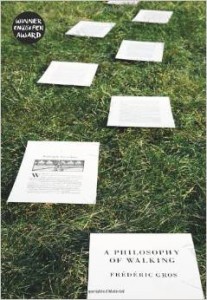I’ve been thinking about walking more. As a way to process the overload of information we deal with on a daily basis. Or as a way to live with more immersion in nature. Or to explore my new city. Or, maybe just because the weather is nicer and it’s not raining all the time.

1. An interesting post on Farnam Street Blog entitled “A Philosophy of Walking: Thoreau, Nietzsche and Kant on Walking” delves into the pedestrian habitats of writers and philosophers and what this could mean in our plugged in and programmed lives, and fits this thinking. As author Share Parrish mentions:
Walking allows us time to play with ideas, explore concepts, and be wrong in our thinking without worrying about others seeing the rawness of our thoughts.
 The post is in reference to the book “A Philosophy of Walking” by Frederick Gros, where he “explores people and lives that were shaped by walking. He ponders Thoreau’s seclusion, why Rimbaud walked in fury, Nerval and his cure to melancholy. Rousseau and Nietzsche walked to think. Kant walked through his town at the same time daily to escape the “compulsion of thought.”
The post is in reference to the book “A Philosophy of Walking” by Frederick Gros, where he “explores people and lives that were shaped by walking. He ponders Thoreau’s seclusion, why Rimbaud walked in fury, Nerval and his cure to melancholy. Rousseau and Nietzsche walked to think. Kant walked through his town at the same time daily to escape the “compulsion of thought.”
There are some specific rules to consider, which are instructive to separate this form of walking from those things considered ‘exercise’.
- As mentioned, foremost, walking is not a sport, and thus requires no training, organization, scorekeeping, or other requirements.
- It is about freedom, to roam, observe, and to let ones mind wander, or to experience the sublimity of surroundings.
- Slowness is a virtue
- It is best done in solitude.
2. This brings up the similar (related/opposing?) concept in terms of the urbanist model of the walker – the flaneur, the observer, passively strolling and observing the city in the 19th Century, as mentioned by Baudelaire, LaRousse, and others specifically in Paris. As noted by Walter Benjamin, the flaneur is an “essentialy figure of the modern urban spectator, an amateur detective and investigator.” and was reflective of the detachment and alienation created by the crowding of the city, mass culture, and industrialization. A quote from Wikipedia mentions this connection:
“Social and economic changes brought by industrialization demand that the artist immerse himself in the metropolis and become, in Baudelaire’s phrase, “A botanist of the sidewalk”
Echoing the 20th century and Georg Simmel in “The Metropolis and Mental Life”, the blase detachment and alienation may be referenced today with the preponderance of headphones and cell phones – but is there a way to turn this on its head? Would/do the creative philosophers of the time walk to disconnect with the world at large and have the head-space to think big thoughts, or is it to immerse in the modern world to understand the dynamism of the modern metropolis.
Is the concept walking and of a modern flaneur an interesting conceptual jumping-off point – not as the next iteration of the jaded, independent observer of urbanity, but using the tools of the explorer and guide to the modern metropolis – incorporating the stories innate in the city, overlaying maps, images, and other spatial knowledge with multimedia, and using of technology and GPS enabled devices to connect it together into our own personal narrative?
Maybe i will take a walk and meditate on this?
See also:
“Walking the Turtle” 02/04/11
“City Limits: Where I Walked” 01/04/10